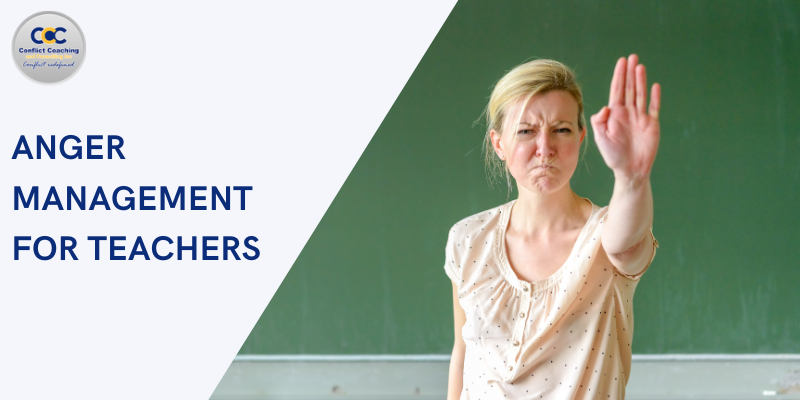
Anger Management for Teachers
Teaching can be a stressful job. With heavy workloads, managing student behavior, and handling administrative tasks, it’s easy for emotions to build up. This can lead to frustration and sometimes anger.
However, anger management for teachers is essential for maintaining a calm and positive classroom environment.
When teachers have control over their emotions, they can engage students better, create a safe space for learning, and reduce stress for themselves.
Importance of Anger Management for Teachers
Teachers who manage their anger create a classroom where students feel safe, engaged, and ready to learn. Uncontrolled anger can lead to fear, anxiety, and poor academic performance in students.
Teachers who practice anger management techniques experience less stress and burnout. It helps them maintain their mental health, improve relationships with colleagues, and feel more satisfied with their work.
What Causes Anger in Teachers?
Anger doesn’t come out of nowhere; it’s often a response to stress and frustration. Teachers face a unique set of challenges that can build up over time.
The pressure to manage a classroom, meet academic goals, and handle additional responsibilities can cause emotions to run high. Understanding where this anger comes from is essential to controlling it.
By identifying the triggers, teachers can develop strategies to handle difficult situations more effectively, keeping their emotions in check.
Common Triggers in the Classroom
Disruptive student behavior: Students who act out can be a major source of frustration. Constant interruptions and disrespect can make maintaining a productive learning environment difficult.
Lack of student engagement: When students aren’t paying attention or participating, it can feel like all the effort a teacher puts into their lessons is wasted, leading to frustration.
Pressure to meet academic targets: Teachers often feel immense pressure to ensure their students perform well on tests and meet educational benchmarks. This pressure can build over time, creating stress and irritation.
External Stressors
Administrative responsibilities: Managing paperwork, attending meetings, and following strict procedures can add extra stress outside of teaching, making it harder to manage emotions in the classroom.
Parental expectations: Teachers face expectations from parents who want the best for their children. Balancing these demands while maintaining classroom order can lead to stress.
Work-life balance: Juggling personal life and teaching can be difficult, especially when work spills over into personal time, leading to frustration and burnout.
Psychological and Emotional Factors
Burnout and fatigue: Teaching is emotionally and physically exhausting. Long hours and constant demands can lead to burnout, often making anger harder to control.
Personal challenges outside of work: Like anyone else, teachers face personal challenges, including family problems, financial issues, or health concerns.
These issues can affect their emotional state in the classroom. These personal stressors can make it more difficult to handle professional stress calmly.
What are the Signs and Symptoms of Teacher Anger
It’s important to recognize when anger is starting to affect a teacher’s behavior and well-being.
Anger can manifest in various ways, and often, teachers may not realize they are showing signs of frustration until it impacts their interactions with students or colleagues.
Identifying these signs early is key to addressing the issue before it escalates.
Teachers aware of their physical, emotional, and behavioral reactions can proactively manage their anger and maintain a positive classroom environment.
Physical Indicators
Anger can cause noticeable physical changes. A rapid heartbeat, muscle tension, and headaches are common symptoms.
These physical signs of stress are the body’s way of reacting to frustration, and if left unmanaged, they can lead to more serious health problems over time.
Emotional Responses
When a teacher feels anger building up, emotional responses like frustration, irritability, and mood swings often follow.
These emotions can make staying calm and patient with students difficult, leading to a negative classroom atmosphere. Recognizing these emotional shifts is crucial to regaining control overreactions.
Behavioral Signs
Anger can also show in a teacher’s behavior. Yelling or using sarcasm with students, avoiding interactions with colleagues or students, and taking excessive disciplinary actions are clear indicators.
These behaviors disrupt the classroom and affect the teacher’s relationships and professional reputation.
Recognizing these patterns early can help teachers prevent anger from controlling their actions.
Consequences of Unmanaged Anger on Teachers and Students
Anger can have serious consequences for teachers and students when left unmanaged.
A teacher’s inability to control their emotions can create a negative atmosphere that impacts the learning process, student-teacher relationships, and the teacher’s own well-being.
Recognizing the harmful effects of unchecked anger is crucial for maintaining a healthy and productive classroom environment.
If left unaddressed, unmanaged anger can lead to long-term issues that affect everyone involved.
Impact on Student Learning
Unmanaged anger can significantly reduce student motivation and performance.
When a teacher reacts angrily, students may become fearful or anxious, making it difficult to focus or engage in learning.
Instead of promoting a love for learning, it creates a fear-based environment where students are more concerned with avoiding mistakes than academic growth.
Damage to Teacher-Student Relationships
Anger-driven responses can lead to a breakdown in trust and respect between teachers and students.
When a teacher is consistently angry or uses harsh discipline, students may lose respect for the teacher, which can negatively impact their behavior.
Over time, these strained relationships can lead to long-lasting behavioral and emotional challenges for students.
Effects on Teacher’s Mental Health
For teachers, the constant buildup of anger and frustration can lead to increased stress and burnout.
Feeling angry or overwhelmed regularly diminishes job satisfaction and can lower performance in the classroom. This, in turn, creates a cycle where stress fuels more anger, eventually leading to emotional exhaustion and possible mental health issues.
Managing anger is essential to preserving both mental health and professional fulfillment.
Effective Anger Management Techniques for Teachers
Managing anger in the classroom requires intentional strategies. Teachers can benefit from various techniques that help them stay calm, focused, and in control during stressful situations.
By incorporating these practices into their daily routine, teachers can reduce the chances of anger taking over and create a more positive, productive classroom environment.
These techniques help manage emotions in the moment and reduce overall stress levels over time.
Reframing Negative Thoughts
Instead of blaming students or external factors for frustrations, teachers can reframe negative thoughts into opportunities for understanding and problem-solving.
Positive Self-Talk
Using affirmations and positive reminders helps teachers stay calm and confident, even in difficult situations.
Take Breaks
When feeling overwhelmed, it’s essential to step away, if possible. Short breaks allow teachers to reset and return to the classroom with a clearer mind.
Breathing Exercises
Deep, controlled breathing helps calm the nervous system and reduce immediate anger. Simple breathing exercises can be used in the classroom when stress levels rise.
Mindfulness in the Classroom
Staying present and focused on the current moment helps teachers avoid overreacting to stressors. Mindfulness can reduce the tendency to dwell on frustrations.
Daily Meditation Practices
Meditating for just a few minutes daily can significantly reduce stress levels, making it easier for teachers to manage emotions throughout the day.
Time Management and Prioritization
By organizing their tasks more effectively, teachers can reduce their feelings of overwhelm. Managing time well minimizes stress and allows for better focus on important tasks.
Peer Support
Talking with other teachers and sharing challenges can provide emotional relief and practical solutions for managing classroom stressors.
Strategies for Preventing Anger in the Classroom
Prevention is key to managing anger in the classroom. By setting clear expectations and using proactive strategies, teachers can reduce situations that lead to frustration.
Building positive relationships with students and regularly assessing their own emotional state can also help teachers create a more harmonious classroom environment.
Establish Clear Classroom Rules and Boundaries
Students are more likely to follow the rules when they know what’s expected of them. A structured environment with clear rules reduces confusion and prevents situations that could trigger anger.
Proactive Classroom Management
Using positive reinforcement and preventive measures, such as reward systems or praise for good behavior, can help manage student conduct before it becomes problematic.
Proactive management decreases the need for reactive discipline, which can lead to frustration.
Fostering Positive Student-Teacher Relationships
When teachers build trust and rapport with students, they create a respectful atmosphere where students are more likely to listen and cooperate.
Regular positive interactions reduce the chances of conflict and promote a smoother learning experience.
Regular Self-Reflection
Encouraging teachers to assess their emotional state allows them to recognize signs of frustration early.
With regular self-reflection, teachers can make adjustments to prevent anger from escalating.
How Schools Can Support Teachers in Managing Anger?
While individual strategies are important, schools also play a crucial role in helping teachers manage their anger and stress.
Schools that actively support their staff’s well-being create a healthier, more productive environment for teachers and students.
Schools can help prevent teacher burnout and foster a positive atmosphere by providing resources, training, and a supportive culture.
A collaborative approach between teachers and administrators is key to creating long-term solutions for managing stress and emotions in the classroom.
Professional Development and Workshops
Schools can offer professional development sessions focused on anger management techniques.
Workshops can teach strategies like conflict resolution, stress reduction, and emotional regulation.
Providing teachers with practical tools to manage classroom challenges equips them to handle stressful situations calmly.
Access to Counseling and Mental Health Services
Access to counseling or mental health services is essential for teachers dealing with chronic stress or anger issues.
Schools can provide on-site counselors or offer resources for external support.
Professional guidance can help teachers navigate personal and work-related stressors more effectively, reducing the chances of anger affecting their classroom performance.
Promoting a Healthy Work-Life Balance
Encouraging a healthy work-life balance is one of the most effective ways to reduce teacher stress.
Schools can implement policies that limit excessive workloads, allow for mental health days, and ensure teachers have time to recharge outside of work.
A balanced schedule helps prevent burnout and keeps teachers emotionally grounded.
Creating a Supportive School Culture
A supportive school culture is vital for teachers to feel comfortable sharing their challenges.
Schools should cultivate an environment where open communication is encouraged, and teachers can discuss their frustrations without fear of judgment.
Peer support groups, mentoring programs, or regular check-ins with administrators can help teachers feel more supported, reducing the buildup of stress and anger.
Conclusion
Managing anger is crucial for creating a healthy and effective teaching environment.
When teachers are overwhelmed by stress, it can negatively impact their well-being and the classroom atmosphere.
By adopting anger management techniques, teachers can maintain better control over their emotions, which leads to improved student relationships, enhanced classroom productivity, and reduced personal stress.
Techniques like reframing negative thoughts, using positive self-talk, and practicing mindfulness can significantly affect how teachers handle difficult situations.
It’s also important to recognize the role schools play in supporting teachers. Schools can help by offering professional development on stress management, providing access to mental health services, and promoting a healthy work-life balance.
Together, these strategies help teachers succeed in their professional lives and improve their personal well-being.
A teacher who can manage their anger and stress effectively will be better equipped to inspire and guide students, making the learning experience more positive for everyone involved.





Responses